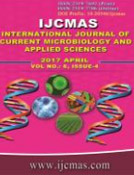


 National Academy of Agricultural Sciences (NAAS)
National Academy of Agricultural Sciences (NAAS)

|
PRINT ISSN : 2319-7692
Online ISSN : 2319-7706 Issues : 12 per year Publisher : Excellent Publishers Email : editorijcmas@gmail.com / submit@ijcmas.com Editor-in-chief: Dr.M.Prakash Index Copernicus ICV 2018: 95.39 NAAS RATING 2020: 5.38 |
A study was undertaken to evaluate the effect of increasing osmotic stress on various germination traits along with the capability of hydropriming and hormonal priming to counteract it. Seeds of five wheat genotypes were tested at four different stress levels viz., 0 bar, -3 bar, -9 bar and -15 bar created using PEG-6000, either seed primed with water (hydropriming) or with GA3 (Gibberellic acid) @ 50 ppm in a completely randomized design with three replications. With increase in osmotic stress from 0 bar to -15 bar, germination traits like germination percentage (81.5% to 15%), plumule length (7.8 cm to 0.4 cm), number of lateral roots (5 to 1.9), fresh weight (124 mg to 77.4 mg) goes down whereas, dry weight (24.7 mg to 40.5 mg) goes up. At 0 and -3 bar GA3 treatment was more effective for enhancing germination percentage (11.5% and 9.5% increase over hydroprimed) whereas at higher stress levels i.e. -9 and -15 bar hydropriming was found to be better than GA3 treatment (8% and 6% increase over GA3). Average germination percentage at all stress levels revealed PBW 175 (55.00 %), C 306 (54.69 %) and MACS 6272 (53.13 %) as osmotic stress tolerant group and UP 2828 (50.63 %) and K 1016 (49.06 %) as osmotic stress susceptible group.
 |
 |
 |
 |
 |